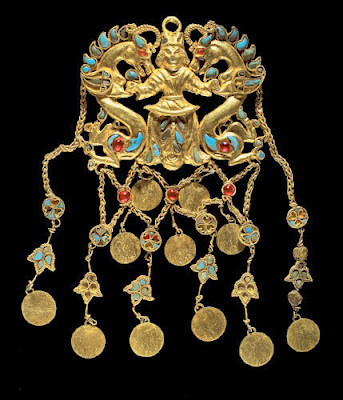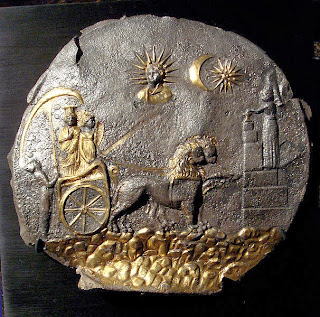 |
| Dr Jean Mulder |
Nearly 230 artefacts from the National Museum in Kabul, Afghanistan, are currently touring Australia. The archaeological treasures that make up this grand exhibit beautifully display ancient Afghanistan’s role as a key player in the exchange of goods and ideas along the trade routes of the Silk Road. Equally intriguing are the modern-day stories that are told of the artefacts’ discovery, excavation, and heroic rescue.
The exhibit covers four archaeological sites. The oldest is Tepe Fullol, a Bronze Age oasis that was in full swing a long time before the Silk Road trade began. Large irrigation systems enabled oasis people such as those of Tepe Fullol to crop the northern Afghanistan desert plains, build fortified settlements and pursue artistic craftsmanship.
 |
| Dragon master pendant 1st century AD |
The former Greek city Aï Khanum, the second site covered in the exhibit, is also in the region of northern Afghanistan which is known to the West as Bactria.
Different cases bring to life various parts of the city, with the bronze, ivory and stone sculptures not only telling us about the legacy of Alexander the Great’s conquest of the Persian Empire (334-323 B.C.), but also about the melding of local and other Asian ideas, products and culture in this far-flung outreach of the Greek empire. Regretfully, Aï Khanum, which was abandoned around 130 BC., is the only true Greco-Bactrian settlement that has ever been excavated.
The greatest archaeological treasures found in Afghanistan, if not in all of Central Asia, are from the third and fourth sites, Begram and Tillya Tepe. And they are truly breathtaking.
But just as enthralling are the stories around these riches. Sometime in the first century A.D., in a fertile valley to the south of the massive Hindu Kush mountains, at the confluence of ancient and modern Silk Road trade routes connecting Afghanistan to Pakistan, for some unknown reason someone in Begram bricked shut two storerooms filled with luxury goods. There they remained, abandoned, until nearly 80 years ago when archaeologists unearthed the two sealed rooms with their undisturbed array of glassware, bronzes, alabaster objects from the Roman world, fragments of Chinese lacquer boxes and bowls, and Indian-style reliefs carved in ivory and bone. (One can only imagine the celebrating that night.)
 |
| Plate depicting Cybele pulling lions, 2nd century BC |
In some ways, though, the real highlight of the exhibit is the exquisite collection of gold artefacts from the famed ‘Bactrian Hoard’ – objects from the 2,000 year old graves of six Bactrian nomads discovered at Tillya Tepe ‘Hill of Gold’ in northern Afghanistan in 1978 but hidden from view until 2003.
The objects themselves range from a crown that was collapsible, with five removable trees of life that could be attached to the golden band, to other jewellery, clasps, appliqués, hair ornaments, belts and bejewelled swords, daggers and sheaths. Included in this sumptuousness are shoe soles cut from thin gold sheet. Clearly they were not to be used for walking. (Like some neighbouring cultural regions, they were actually a sign of an aristocratic way of life.)
 |
| Collapsible gold crown, Tilya Tepe, 1st century AD |
I had the good fortunate to see this exhibit just before it finished in Melbourne. It not only left me very nostalgic for my trip to Uzbekistan, arranged by Uzbek Journeys, but it also gave me a greater understanding of the historical timelines and cultural significance of places and events that I learned about during my recent initiation to Central Asia.
If you are travelling to Central Asia, whether for the first or the umpteenth time, or are interested in the cultural heritage of this region, the exhibit is a must-see. The catalogue is highly recommended.
The remaining Australian exhibition dates are:
Queensland Museum: 5 September 2013 – 27 January 2014
Art Gallery of New South Wales: 6 March – 1 June 2014
Western Australian Museum: 5 July – 16 November 2014
 |
| Glass flask in the shape of a fish, 1st century AD |
Afghan Art - Tradition & Continuity at the Museum of Islamic Art, Doha
Alexander the Great's March from St Petersburgh to Sydney
Image source: All images by Thierry Olivier, Musée Guimet, Paris